| Penumbral eclipse | |||||||||
 The Moon's hourly motion shown right to left The Moon's hourly motion shown right to left | |||||||||
| Date | August 17, 2027 | ||||||||
|---|---|---|---|---|---|---|---|---|---|
| Gamma | 1.2797 | ||||||||
| Magnitude | −0.5234 | ||||||||
| Saros cycle | 148 (4 of 71) | ||||||||
| Penumbral | 218 minutes, 35 seconds | ||||||||
| |||||||||
| ← July 2027January 2028 → | |||||||||
A penumbral lunar eclipse will occur at the Moon’s ascending node of orbit on Tuesday, August 17, 2027, with an umbral magnitude of −0.5234. A lunar eclipse occurs when the Moon moves into the Earth's shadow, causing the Moon to be darkened. A penumbral lunar eclipse occurs when part or all of the Moon's near side passes into the Earth's penumbra. Unlike a solar eclipse, which can only be viewed from a relatively small area of the world, a lunar eclipse may be viewed from anywhere on the night side of Earth. Occurring about 1.9 days after apogee (on August 15, 2027, at 10:20 UTC), the Moon's apparent diameter will be smaller.
Visibility
The eclipse will be completely visible over North and South America, seen rising over Australia and the central Pacific Ocean and setting over west Africa.
 
|
Eclipse details
Shown below is a table displaying details about this particular solar eclipse. It describes various parameters pertaining to this eclipse.
| Parameter | Value |
|---|---|
| Penumbral Magnitude | 0.54758 |
| Umbral Magnitude | −0.52344 |
| Gamma | 1.27974 |
| Sun Right Ascension | 09h45m58.6s |
| Sun Declination | +13°27'30.2" |
| Sun Semi-Diameter | 15'47.8" |
| Sun Equatorial Horizontal Parallax | 08.7" |
| Moon Right Ascension | 21h43m58.8s |
| Moon Declination | -12°24'40.9" |
| Moon Semi-Diameter | 14'44.9" |
| Moon Equatorial Horizontal Parallax | 0°54'07.8" |
| ΔT | 72.8 s |
Eclipse season
See also: Eclipse cycleThis eclipse is part of an eclipse season, a period, roughly every six months, when eclipses occur. Only two (or occasionally three) eclipse seasons occur each year, and each season lasts about 35 days and repeats just short of six months (173 days) later; thus two full eclipse seasons always occur each year. Either two or three eclipses happen each eclipse season. In the sequence below, each eclipse is separated by a fortnight. The first and last eclipse in this sequence is separated by one synodic month.
| July 18 Ascending node (full moon) |
August 2 Descending node (new moon) |
August 17 Ascending node (full moon) |
|---|---|---|
 |
 |

|
| Penumbral lunar eclipse Lunar Saros 110 |
Total solar eclipse Solar Saros 136 |
Penumbral lunar eclipse Lunar Saros 148 |
Related eclipses
Eclipses in 2027
- An annular solar eclipse on February 6.
- A penumbral lunar eclipse on February 20.
- A penumbral lunar eclipse on July 18.
- A total solar eclipse on August 2.
- A penumbral lunar eclipse on August 17.
Metonic
- Preceded by: Lunar eclipse of October 28, 2023
- Followed by: Lunar eclipse of June 5, 2031
Tzolkinex
- Preceded by: Lunar eclipse of July 5, 2020
- Followed by: Lunar eclipse of September 28, 2034
Half-Saros
- Preceded by: Solar eclipse of August 11, 2018
- Followed by: Solar eclipse of August 21, 2036
Tritos
- Preceded by: Lunar eclipse of September 16, 2016
- Followed by: Lunar eclipse of July 16, 2038
Lunar Saros 148
- Preceded by: Lunar eclipse of August 6, 2009
- Followed by: Lunar eclipse of August 27, 2045
Inex
- Preceded by: Lunar eclipse of September 6, 1998
- Followed by: Lunar eclipse of July 26, 2056
Triad
- Preceded by: Lunar eclipse of October 16, 1940
- Followed by: Lunar eclipse of June 18, 2114
Lunar eclipses of 2024–2027
This eclipse is a member of a semester series. An eclipse in a semester series of lunar eclipses repeats approximately every 177 days and 4 hours (a semester) at alternating nodes of the Moon's orbit.
The penumbral lunar eclipse on July 18, 2027 occurs in the next lunar year eclipse set.
| Lunar eclipse series sets from 2024 to 2027 | ||||||||
|---|---|---|---|---|---|---|---|---|
| Descending node | Ascending node | |||||||
| Saros | Date Viewing |
Type Chart |
Gamma | Saros | Date Viewing |
Type Chart |
Gamma | |
113
|
2024 Mar 25
|
Penumbral
|
1.0610 | 118
|
2024 Sep 18
|
Partial
|
−0.9792 | |
| 123 | 2025 Mar 14
|
Total
|
0.3485 | 128 | 2025 Sep 07
|
Total
|
−0.2752 | |
| 133 | 2026 Mar 03
|
Total
|
−0.3765 | 138 | 2026 Aug 28
|
Partial
|
0.4964 | |
| 143 | 2027 Feb 20
|
Penumbral
|
−1.0480 | 148 | 2027 Aug 17
|
Penumbral
|
1.2797 | |
Saros 148
It is part of Saros cycle 148.
Metonic series
The Metonic cycle repeats nearly exactly every 19 years and represents a Saros cycle plus one lunar year. Because it occurs on the same calendar date, the Earth's shadow will in nearly the same location relative to the background stars.
| Descending node | Ascending node | |||||
|---|---|---|---|---|---|---|
| Saros | Date | Type | Saros | Date | Type | |
| 103 | 1951 Feb 21.88 | Penumbral | 108 | 1951 Aug 17.13 | Penumbral | |

|

| |||||
| 113 | 1970 Feb 21.35 | Partial | 118 | 1970 Aug 17.14 | Partial | |
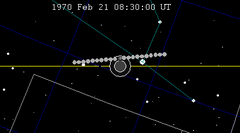
|
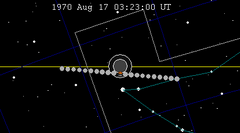
| |||||
| 123 | 1989 Feb 20.64 | Total | 128 | 1989 Aug 17.13 | Total | |
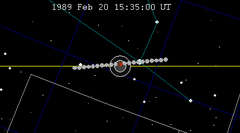
|
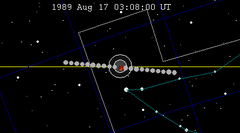
| |||||
| 133 | 2008 Feb 21.14 | Total | 138 | 2008 Aug 16.88 | Partial | |

|
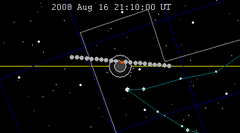
| |||||
| 143 | 2027 Feb 20.96 | Penumbral | 148 | 2027 Aug 17.30 | Penumbral | |
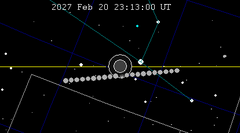
|
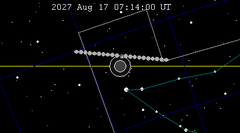
| |||||
Half-Saros cycle
A lunar eclipse will be preceded and followed by solar eclipses by 9 years and 5.5 days (a half saros). This lunar eclipse is related to two partial solar eclipses of Solar Saros 155.
| August 11, 2018 | August 21, 2036 |
|---|---|

|
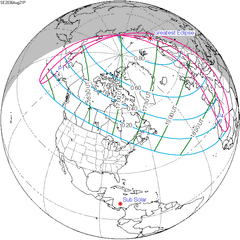
|
See also
References
- "August 16–17, 2027 Penumbral Lunar Eclipse". timeanddate. Retrieved 19 November 2024.
- "Moon Distances for London, United Kingdom, England". timeanddate. Retrieved 19 November 2024.
- "Penumbral Lunar Eclipse of 2027 Aug 17" (PDF). NASA. Retrieved 19 November 2024.
- "Penumbral Lunar Eclipse of 2027 Aug 17". EclipseWise.com. Retrieved 19 November 2024.
- van Gent, R.H. "Solar- and Lunar-Eclipse Predictions from Antiquity to the Present". A Catalogue of Eclipse Cycles. Utrecht University. Retrieved 6 October 2018.
- Mathematical Astronomy Morsels, Jean Meeus, p.110, Chapter 18, The half-saros
External links
- Saros cycle 148
- 2027 Aug 17 chart: Eclipse Predictions by Fred Espenak, NASA/GSFC
This lunar eclipse-related article is a stub. You can help Misplaced Pages by expanding it. |


